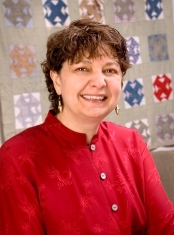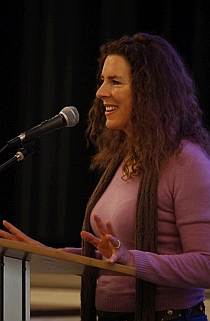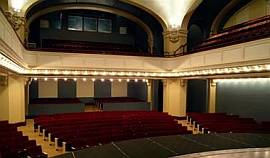Post-FilmDiscussion
Discussion Leaders:
Maggie Barnes, painter, photographer, musician
Mary Pierce Brosmer, teacher, writer, poet, activist
M. Katherine Hurley, painter, curator
Aymie Majerski, film and video producer
 Maggie Barnes
Maggie Barnes
Maggie's inspiration to paint came while grieving the death of a close friend. That it came at that point in her life was a bit of a surprise -- she had taken a few art classes in college, but never painted. She a Masters in Education from Xavier University and was
trained to be a high school English teacher.
Maggie relates that she paints because it offers indescribable balance and relief, "It allows me to accept and resolve things I perceive to be chaotic and imperfect and through grace find an authentic purpose, a harmonious arrangement to it all."
Opening a studio at the Essex offered a wonderful place to paint and brought her into the community of other artists, where she became a member of the Essex Studios Artists Guild. Currently, Maggie has work exhibited at the Kennedy Heights Arts Center in Kennedy Heights, Ohio, where she is a member of the Kennedy Guild and facilitates a weekly study of Julia Cameron's The Artist's Way: A Spiritual Path to Higher Creativity.
"The balance between home life and being an artist is sometimes tricky," says Maggie. As the mother of two young and very energetic children and a cancer survivor, Maggie credits a wonderfully supportive husband and her own ability to multi-task. Even though she's become established (a series of her work was recently exhibited at ONE in Notting Hill, London, England), she occasionally hears the word "hobby" applied to her artistic endeavors. "I know they don't understand -- I have to paint, it's what I'm here to do."
"To fall asleep at the end of the day enveloped in reflective gratitude is something I work toward each day; thankful for the inexplicable peace that painting offers me and grateful to have the opportunity."
Learn more about Maggie Barnes and her work:
ArtworkByMaggie.Com.
Also, Maggie is a photographer and plays violin in a trio with two acoustic guitarists.
 Mary Pierce Brosmer
Mary Pierce Brosmer
Mary Pierce Brosmer is a poet, writer, teacher, mother, grandmother and a visionary for saner communities and organizations. After receiving an English degree, she became a high school teacher. When she became a mother, she chose to stay home with her son for two years, with future plans for a doctoral degree. Things changed when she divorced at 35.
Subsequently, Brosmer spent a lot of time using her own writing to sort out where she was going with her life. From a dream about women gathered around a table sharing their stories, she founded Women Writing for (a) Change with 15 students in 1991. This safe place for women to speak their truths to one another has grown into a program with roughly 200 students enrolled in classes at the Cincinnati center.
WWf(a)C has blossomed over the years, spawning a foundation that offers writing scholarships, a young women's writing program and myriad outreach programs with schools, social service agencies and other arts and non-profit organizations; plus a consulting arm that helps organizations achieve focus and success.
The development of the Feminist Leadership Academy in 2004 brought expansion of the program, reaching women throughout the country. Nine cities, including Cincinnati, New York City, Seattle, Indianapolis, Louisville, Ky., Burlington, Vt., Grand Junction, Colo., Bloomington, Ind., and Birmingham, Ala., now have WWf(a)C centers.
Learn more about Mary Pierce Brosmer and her work:
WomenWriting.Org and
ConsultingForAChange.Com.
 M. Katherine Hurley
M. Katherine Hurley
Kay Hurley is from a small town in Ohio called Gates Mills, known for its New England-like charm, rolling hills and horse farms. Horses were her first love and throughout her teens she cared for and trained them. The barns became a sanctuary and riding through the beautiful hills and valleys was a serene and soulful experience. These roots drive Kay's passion about landscape painting through which she shares that particular sense of peace and beauty.
After concentrating in art in high school at Notre Dame Academy in Chardon, Ohio, in 1974 she received her BFA at The College of Mt. St. Joseph in Cincinnati, Ohio. She continued her studies at The Art Academy of Cincinnati and worked with renowned colorist and landscape painter, Wolf Kahn. For over 30 years, she has been a working artist in Cincinnati and has raised her family here.
Kay has exhibited in Europe and is represented in several premier galleries in the U.S.A. A Signature member of the Pastel Society of America, her work can also be found in numerous private and corporate collections throughout the United States. In addition to solo and group exhibits, her work has been featured in The Pastel Journal and most recently in The Artist's Magazine (Jan/Feb 2008 and June 2008). She enjoys teaching, conducting workshops and mentoring young art students.
Cincinnati art historian, critic and writer, Daniel Brown writes: "Hurley's work is the search for essences, not likenesses ... and symbolically represents nature/ life, growth and beauty. The synchronicity of styles - between her own art and that of the American Luminists and the Song painters of the Northern and Southern dynasties- brings her to the forefront, in my opinion, of America's contemporary landscape artists."
Learn more about Kay Hurley and her work:
MKatherineHurley.com.
 Aymie Majerski
Aymie Majerski
Aymie Majerski is Executive Producer and founding partner of Barking Fish Lounge, Barking Fish Entertainment and Reel Kids, LLC., based in the Covington Arts District.
With a BA in Fine Arts from the University of Montana where she majored in directing and acting, Aymie started on stage and in front of the camera then gravitated to the tech side. She has accumulated extensive production credits over the past decade in a variety of genres - indie shorts, independent feature films, music videos and television series. Not a person to be pigeon-holed, Aymie finds time to hone her acting skills, with a recent appearance in Tartuffe.
As a producer, her current projects include a documentary, an animated series and a feel-good reality show, but her favorite is IndieVisuals.com, an online video sharing community she founded so that young filmmakers, ages 8 to 17, can acquire the knowledge and tools for creating their own videos while sharing their work with their friends. As the 30-something mother of 11- and 14-year-old girls, Aymie knows the importance of providing family-friendly, safe websites for young people where they can create and share video works with their peers.
Learn more about Aymie Majerski and her work:
BarkingFishLounge.com and
IndieVizuals.com.
|
|
Interview with the Director, Pamela Boll:
Q&A: From the director's chair,
Who Does She Think She Is?
By Eric Tsetsi, Winchester Star, Jan 06, 2009 © 2009, Gatehouse News Service Permalink
Winchester, MA -- The highly acclaimed documentary, "Who Does She Think She Is?" directed and produced by Pamela Tanner Boll, is now being shown at the Museum of Fine Arts in Boston. Boll, who also co-executive produced the documentary, "Born Into Brothels," recently discussed her film with The Winchester Star.
 Q: What prompted you to pursue this particular project and now that it has been realized, how has it changed you?
Q: What prompted you to pursue this particular project and now that it has been realized, how has it changed you?
A: While I had managed to paint and to hold some shows of my work as well as to write and to publish some of this work ... while my children were at home, I always felt I could have been doing more. When the boys entered their teens and began to pursue their own interests, I was bereft. I had been at the center of their world for so long and missed this. At the same time, I felt that I had neglected my own early promise -- I was in my mid-40s and had no book to my name and had few exhibitions of my work.
Then, I attended a documentary film that a friend had produced. She and I used to teach writing at Harvard in the mid-nineties. With no previous experience in film, she had produced an extraordinary film, "The Day My God Died," about sex trafficking in Nepal and India. I sat in the audience in tears at the beauty of this work, at its power and at its meaning. I wanted my work to have this same kind of resonance and scope.
Soon after, I heard about Maye Torres, a woman in her mid-forties with three teen age boys like me, who was making her living with her art. She lived in the desert on the far side of the Rio Grande in New Mexico. I wondered how she was able to continue to make art when it paid so little and when she had the care and responsibility of these children.
Six months later, after having dreamt of Maye, I flew to New Mexico to meet with her. The moment I saw her, with her long black hair knotted down her back, huge smile and stunning work, I knew I wanted to document her life. That was the beginning of "Who Does She Think She Is?"
Q: How does "Who Does She Think She Is?" reflect your own life, and your struggles with family, work, and your instinctual creativity?
A: As a young woman, I studied art and also creative writing. I pursued both of these disciplines through college, and wrote a book of poetry for my Senior Thesis. However, I decided not to pursue either as a career; I felt it would be too difficult to make a living from the blank page. Instead, I went into Publishing, where I thought that helping others realize their creative projects would be fulfilling.
For the next twelve years, I worked in the business world -- first in publishing, then international grain trading and then for a start up records management company. Each job was challenging in certain respects, and each earned me a reasonable salary. But, in truth, I was deeply bored by the work itself.
My husband and I then had our first child. I had planned on going back to work. But, on my son's birth, I could not imagine leaving him to go back to writing about underground record storage. I fell completely, madly in love with this little boy and soon had two more sons. I loved taking care of them and was also constantly worried about how to do the best job. This nurturing of a new being was the scariest, most absorbing, loneliest, most exhausting, joyous and most compelling work I had ever done. I began to write out of desperation, to make sense of it all. Soon after, I began to paint again, too. It was as though the birth of these children brought me back to my creative self. I had no choice but to put all that I felt and thought onto paper -- after such a long leaving. They woke me up.
Yet, even as the birth and care-giving of my sons brought me back to creative expression, I was constantly torn between fulfilling their needs and making time and space for my own need to create. For twenty years, I have juggled these two -- and have often felt that I was in the wrong place at the wrong time. Particularly when the boys were little, I felt my heart was being torn out, as I tried to leave the house to go write. They would cry and cling to me, begging me not to go.
"Who Does She Think She Is?" is the result of struggling with these issues.
 Q: How did your work as an executive producer for "Born into Brothels," influence your pursuit of this new project?
Q: How did your work as an executive producer for "Born into Brothels," influence your pursuit of this new project?
A: I came across the film "Born Into Brothels" while I was looking for women of extraordinary vision and drive to profile for "Who Does She Think She Is?" I wanted to interview "Born's" Director, Zana Briski for my film.
I did interview Zana and her co-Director, Ross Kaufmann, in the fall of 2003. They gave me a rough cut of their film, which had been accepted at Sundance. However, they were having a very hard time finishing the film because they had run out of money. I watched the rough cut and realized what a wonderful story this could be and made a decision to help them finish it. I actually ended up putting my own project aside for the year of 2004 so as to help my friend and Executive Producer, Geralyn White Dreyfous as well as Zana and Ross to finish making and to promote "Born Into Brothels."
Q: This film focuses largely on the struggles that women go through to balance family obligations with their art, but what do you think it has to teach other would-be artists (namely men) striving to pursue their calling?
A: While I focused on the struggles women go through, I feel that this is actually, a universal story. It is the story of how one does the work they feel called to do while taking care of the people one loves. It is about pursuing a dream and not leaving those one loves behind.
I focused on "artists" because art is often dismissed as a hobby. It is not considered "real work" -- and this is true even if done by a man. Artists rarely are able to make a living at their work -- and this holds true for writers, painters, musicians, dancers, storytellers. Yet, without visual images, without music, without stories, what kind of life would it be? So, one question is how do you have the courage to pursue work when it does not pay, when it is dismissed by society, and even by those around you?
Many men have told me that they can relate to the stories in this film. I think many men feel as caught by the need to "make a good living" in order to support themselves and a family, as these women do in struggling between the extraordinarily important work of care giving and their expressive work.
Having said this, I do feel that women are in a particular and peculiar position in regards to creative work. For most of history, women have been seen as the Muse or the subject of art, the role of Mother, of nurturing is often portrayed as the highest calling, and yet, it is not paid. The face of poverty around the world is not a man -- it is a woman.
Women do the unpaid work of care giving, birthing and taking care of little ones -- with the understanding that a man and his paid work will support her. This system is such that 70 percent of those earning less than $2 a day are women. So, how does this relate to the arts? Well, women who have the responsibility of care giving who then take on the often up paid "work" of the arts is doubly at risk of poverty.
Q: What did you learn about yourself, and the struggle of balancing the many aspects of life, through your interviews with the women featured in the documentary?
A: One of the best things I learned was that despite my fears that I had not pursued my calling as an artist -- that I was more like the women I interviewed than not. They each felt torn between their creative and nurturing work. They each felt that they had just little bits of time to do this work. In interviewing each of these women, I could look back and see that what seemed piecemeal and unsatisfactory about my writing and painting, was, instead, preparing the groundwork.
Since finishing the film last spring, I have written a creative thesis for my Masters Degree, published several of my short stories and essays and have begun to put together a project for a book about creativity.
Another good thing that came out of this project was that my sons have a new understanding of my life and my values and a new respect for me. Each of my sons have worked on the film at one time or another. My oldest has worked as a camera assistant and went on several shoots. My two younger sons have helped with promotion and have attended many screenings. It has been an extraordinary gift to be able to bring my sons into my life in this way ... and it has been a gift to them to see their mother doing work she is passionate about.
Additional Pamela Boll interviews:
Wall Street Journal Toronto Revue Cinema WomenArts.Org
|




 Maggie Barnes
Maggie Barnes
 Mary Pierce Brosmer
Mary Pierce Brosmer
 M. Katherine Hurley
M. Katherine Hurley
 Aymie Majerski
Aymie Majerski
 Q: What prompted you to pursue this particular project and now that it has been realized, how has it changed you?
Q: What prompted you to pursue this particular project and now that it has been realized, how has it changed you?
 Q: How did your work as an executive producer for "Born into Brothels," influence your pursuit of this new project?
Q: How did your work as an executive producer for "Born into Brothels," influence your pursuit of this new project?